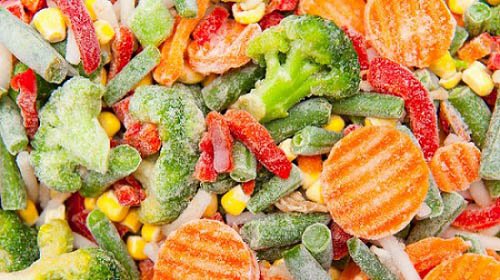1. Golden rules in freezing food
To prevent the risks of getting out of control when freezing food, you should know the correct principles of freezing food from the beginning. Remember that when you freeze food, you should keep these 5 principles in mind:
- Prevent freezer burn
- Prevents moisture loss
- Prevent odor transfer to other foods.
- Use the freezer space you have wisely
- Prevent food poisoning when you freeze food
The key to accomplishing these goals lies in food packaging and how you store it. Here are the golden rules to implement the above principle:
- Leave as little air in the freezer compartments as possible, by removing all the air from the freezer bags before you seal them. You should use freezer-safe containers that are appropriate for the amount of food being frozen.

It is necessary to remove all air from the freezer bag before placing it in the freezer
- Wrap meats and roasts tightly with foil before you place them in freezer bags. Remember that meat frozen in store packaging (wrapped in plastic and placed on a Styrofoam tray) is not ideal for storing well in the freezer. However, that method is still acceptable if you use them within a month.
- To freeze your food as quickly as possible to prevent bacterial growth, use small food containers - with a capacity no larger than 4 liters.
- Cool your hot food quickly before freezing by placing the pan of hot food in a large container filled with ice or ice water, stirring frequently to keep it cold. If you're refrigerating a lot of hot food, like a large pot of stew with chili, divide it into smaller, shallower containers.
- Pack or bag the food and label it or simply write the freeze date on it, even if you think you'll use the food within a week or two.
- Place these boxes of food in the coldest part of your freezer if possible, until they are completely frozen.
- Thawing food at room temperature is only good for muffins, breads and other baked goods. For other foods, choose to defrost in the refrigerator or defrost in the microwave and use the "thaw" mode.
- Try to use your frozen foods within two to three months.
When you freeze food items that contain milk or breast milk. Remember that while you freeze your milk, they may separate a bit once defrosted. Hard and semi-hard cheeses weighing from 227 grams to 454 grams can be stored in the freezer.
When you first buy them from the supermarket, these cheese pieces are already wrapped in a layer of plastic and have been vacuum-sealed. You can always put them in the freezer. Although defrosted cheese retains its characteristic flavor, it can be a bit crumbly and is better suited to adding to cooked dishes. Cheeses that are not well suited to freezing are cream cheese and cottage cheese. Blue cheese will most likely become crumbly after you defrost it.
2. How long can you keep frozen food?
The question is how long can you keep a certain food in the freezer before it becomes unusable? Check the use-by date on foods when you buy frozen foods. For commonly frozen foods, here is the FDA's recommended time schedule that can provide optimal quality:
- Bacon and sausage: 1-2 months
- Casseroles: 2-3 months
- Soups and stews: 2 months
- Pre-wrapped but unroasted roasts: 4-12 months
- Uncooked ground meat: 3-4 months
- Uncooked whole poultry: 12 months
- Uncooked poultry parts: 9 months
- Cooked poultry: 4 months
For food not listed above, defrost it and check its quality. First, by smell. If you find food that smells unusual, you should throw it away.
If your food doesn't look very good but is okay, you can try using it in soups or stews. If the food has frozen spots, simply cut away the burned spots. As for raw foods, cook them, and if you like their taste then it's okay to eat them.
3. Some facts about freezing

Most frozen vegetables can be cooked directly without defrosting
Here are some other facts you might not know about frozen foods:
- Cooling to 0 degrees inactivates microbes (such as bacteria and mold) but it does not kill them. When a food is defrosted, the bacteria can become active again and multiply, under certain conditions.
- Have you noticed that the amount of water in food is more when frozen? The high water content in fruits and vegetables causes their cell walls to break down, so they contain a lot of frozen water inside. This is why defrosted foods sometimes have a mushy texture.




